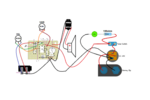bzblues
Full Member level 1
Hi guys! its me again. The amp is awesome! sounds amazing for beeing such a small thing. I have a couple of questions:
1) I want to add a speaker out jack. I'd built a kit (picture attached) that has a speaker out and I added it to the ruby amp, but I only took the out wires that went to the speaker, solder them into the jack, and from the jack, another two wires to the speaker of the ruby but it didn't work. So, I know that I didn't solder the wire from the volume pot to the jack as the picture shows (I'll try that of course)
But what I don't understand is: if the signal "travels" from the circuit board to the speaker thru those two wires, why it doesn't work if the signal goes to the speaker out jack, and then I plug a guitar cable to another speaker cabinet with a 1/4 inch jack aswell?
2) Is there any way to increase the power of the amp ? it delivers 1/2 watt, but maybe there is a way. I've been researching, there are some cool mods, but only to modify the sound of the amp.
(Sorry about the messy drawings!)
Thanks!
1) I want to add a speaker out jack. I'd built a kit (picture attached) that has a speaker out and I added it to the ruby amp, but I only took the out wires that went to the speaker, solder them into the jack, and from the jack, another two wires to the speaker of the ruby but it didn't work. So, I know that I didn't solder the wire from the volume pot to the jack as the picture shows (I'll try that of course)
But what I don't understand is: if the signal "travels" from the circuit board to the speaker thru those two wires, why it doesn't work if the signal goes to the speaker out jack, and then I plug a guitar cable to another speaker cabinet with a 1/4 inch jack aswell?
2) Is there any way to increase the power of the amp ? it delivers 1/2 watt, but maybe there is a way. I've been researching, there are some cool mods, but only to modify the sound of the amp.
(Sorry about the messy drawings!)
Thanks!

